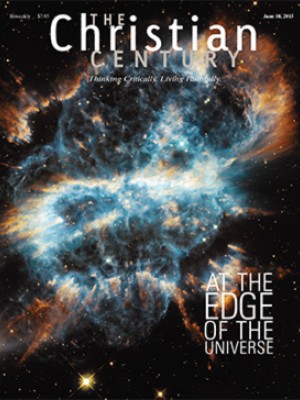Looking together
On a visit to my parents recently, I walked down to a pond near their house. On some visits, this pond is not much more than a mud hole. But Kentucky had had two days of long, soaking rains, and the pond was full, so I wandered over to see what the ducks were doing.
As I turned into the path that leads down to the water, a woman walking her dog gestured to me and called out, “Come here! Check this out!” I stood next to her and followed her pointing finger with my eyes. After a moment I saw it: something sleek and furry was gracefully swimming, undulating through the water.
Read our latest issue or browse back issues.
“What is that?” she asked. “I don’t know,” I said. “An otter?” We watched as it turned over on its back, lifting its belly to the sun. “A beaver,” she said. “I think that’s a beaver.” We watched it slip beneath the water and waited to see if it would come up again. But it had disappeared.
The woman carefully cataloged for me all the wildlife she had seen in the pond over the years: box turtles and snapping turtles, bullfrogs and mallards, geese and herons. And now this beaver. We looked together at the small pond and marveled.
Virginia Woolf writes of the power of looking together in her novel To the Lighthouse. During a dinner party, a woman and a man who ordinarily rub each other the wrong way find themselves looking together at a beautiful bowl of fruit. The woman notes that his way of looking at things is different from her way of looking at things. “But looking together,” Woolf writes, “united them.”
Teachers sometimes think of their work as inviting students to look together at some third thing: a text, a work of art, or an idea. Does looking together unite us? Not in the sense that we all agree on what we see or what it means. But in the shared work of bringing our attention to something outside of ourselves and helping each other see it from other perspectives, we are united in our looking even when we “look” in different ways.
The invitation to look together runs from student to teacher as well as from teacher to student. The most powerful invitation to look together that I had during this school year came from my students. A few days after a grand jury failed to bring an indictment in the death of Eric Garner—a death that had been ruled a homicide by the medical examiner—I went to church, where my colleague Jonathan Walton urged us to look together at what we’ve been willing to tolerate as a society: prisons used as a for-profit form of social control. He urged us to look together—with each other, but also with God—at all the lives lost to police violence and mass incarceration. Try to see the way God sees, he urged us, with the eyes of love.
After the service ended, the congregation lined up to shake his hand and pass through the front doors of the church. But when we walked outside we found that the porch of the church and the steps, the sidewalks, and the gardens around the church were covered with the bodies of our students. They lay very silent and very still. Some were wearing masks over their nose and mouth that said, “I can’t breathe.”
We had to step carefully among them to get down the steps; we had to hold onto one another’s hands and balance our weight on each other’s shoulders to keep from stepping on an arm or a leg or a face. The students did not shift their bodies to make it any easier. They did not move at all. In their disciplined silence, it was possible to hear their plea: look with us at what is happening in this country. Look. See the violence wrought on black people by state power. See how contrary it is to everything Christ taught to tolerate that violence week after week without resistance.
Sometimes we look together in order to marvel and appreciate; sometimes we look together to critique and debate. Sometimes we look together in order to see something we would not have seen without someone to point it out to us—especially when it’s been in front of us for a long time, obscured by the log in our eye.
It is a blessing to have someone come stand alongside us to point out what might have remained invisible to us. Looking together, we cannot rely on tired old justifications for not seeing what is in front of us. Looking together, we can see beyond the limitations of our individual vision. Looking together with each other and with God, we can see not only the world as it is but also the world as it might become. Looking together, we are compelled by the mystery of human beings made in the image of God and can marvel, change, and act.







